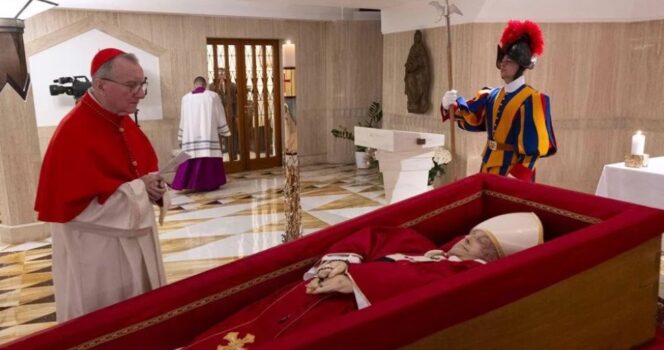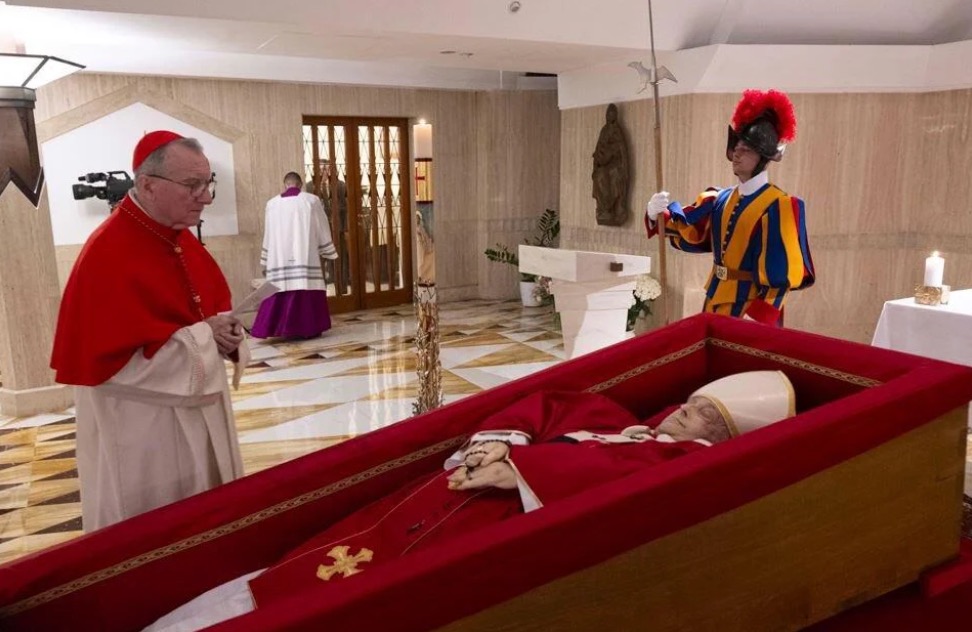Pope Francis, one of the most beloved and transformative figures in the history of the Catholic Church, passed away at the age of 88 following complications from a stroke and pneumonia. As the Vatican released the first images of the late pontiff in repose, a global wave of mourning and reflection swept across nations, religious communities, and millions of individuals who were touched by his message of humility, service, and compassion.
The photographs released by the Vatican show Pope Francis lying peacefully in an open coffin inside St. Peter’s Basilica. These images not only commemorate his life but also subtly highlight a shift in papal tradition—one that Francis himself initiated in life and in death.
A Life Marked by Simplicity and Service

Born Jorge Mario Bergoglio in Buenos Aires, Argentina, Pope Francis was elected the 266th pope of the Roman Catholic Church on March 13, 2013. He was the first Jesuit pope, the first from the Americas, and the first non-European pope in over 1,200 years.
His papacy was characterized by an emphasis on simplicity, social justice, and outreach to the marginalized. He declined luxurious papal apartments, opting instead to live in the modest Casa Santa Marta guesthouse. His papal attire and transportation choices consistently reflected humility. According to Vatican News, Francis frequently urged clergy and laypersons alike to embrace a simpler, more Christ-centered life.
The Final Images: Symbols of a Life Well Lived

The Vatican released the first official photos of Pope Francis on Tuesday, shortly after his passing. Lying in repose in a simple wooden coffin, Francis is dressed in red vestments, symbolizing the blood of Christ and the legacy of martyrdom. A rosary is gently folded into his hands—an intimate reminder of his devotion to prayer and intercession.
Placed beside him are traditional papal items, including:
-
The mitre (a ceremonial headdress worn by bishops)
-
The crozier (a pastoral staff symbolizing his role as shepherd of the Church)
-
The Fisherman’s Ring, ceremonially broken to prevent posthumous misuse
-
A collection of papal coins minted during his tenure
-
A “rogito”, a sealed legal document summarizing his life and papacy
These items, steeped in centuries-old tradition, symbolize both continuity and change—a blend of papal heritage and Francis’s personal humility.
A Humble Coffin That Speaks Volumes

Unlike previous popes who were laid to rest in elaborate triple-layer coffins made of cypress, lead, and oak, Pope Francis chose a single wooden casket lined with zinc. This decision echoes his lifelong commitment to modesty and his frequent calls for a “Church for the poor.”
According to the Associated Press, the pope also requested that his body not be placed on an ornate catafalque (a raised bier). Instead, his coffin will lie at ground level, facing the pews, flanked by a Paschal candle—an enduring Christian symbol of light and hope.
A Departure from Burial Traditions

In another break from centuries of tradition, Pope Francis will not be buried in the Vatican grottoes beneath St. Peter’s Basilica where nearly 90 of his predecessors rest. Instead, his final resting place will be at the Basilica of Santa Maria Maggiore in Rome’s Esquilino neighborhood—a sacred site close to his heart.
This basilica, one of the four major papal basilicas in Rome, was where Francis would often stop to pray before and after international trips. According to BBC News, he expressed his desire to be buried there, reflecting his deep Marian devotion and his preference for simplicity over grandeur.
The Funeral Ceremony
The Vatican has officially confirmed that the funeral of Pope Francis will take place on Saturday, April 26, at 10:00 AM local time in St. Peter’s Square. The event is expected to draw heads of state, religious leaders, and faithful pilgrims from around the world.
The public will be able to pay their respects starting Wednesday as his body lies in state inside St. Peter’s Basilica. The Litany of the Saints—a traditional Catholic hymn invoking the saints—is scheduled to be sung during the procession, led by the camerlengo, Cardinal Kevin Joseph Farrell.
Unlike traditional ceremonies, Francis’s funeral will include simplified rites and omit some of the more extravagant pageantry of the past. This decision aligns with the themes of renewal and humility that defined his papacy.
Global Reaction and Mourning
World leaders and religious communities have issued heartfelt tributes to Pope Francis. United Nations Secretary-General António Guterres praised him as “a voice for peace and the environment,” while Archbishop of Canterbury Justin Welby called him “a beacon of reconciliation in an increasingly divided world.”
Catholics and non-Catholics alike have flooded social media with messages of remembrance and gratitude. Hashtags such as #ThankYouFrancis and #PopeFrancisLegacy trended globally within hours of the announcement of his passing.
A Lasting Legacy
Though his life on Earth has ended, the legacy of Pope Francis will endure through his teachings, his papal encyclicals, and the countless reforms he enacted.
Some of the key highlights of his legacy include:
-
Laudato si’, his encyclical on climate change and environmental stewardship
-
His efforts to reform the Roman Curia
-
The Year of Mercy initiative, which encouraged compassion and forgiveness
-
His vocal support for refugees and the marginalized
-
Emphasis on interfaith dialogue, particularly with the Islamic and Jewish communities
In the words of Cardinal Pietro Parolin, the Vatican Secretary of State: “Pope Francis taught us that to be great is to serve. His death reminds us that humility is the path to holiness.”
Final Reflections
Pope Francis’s death, like his life, serves as a powerful reflection of values rooted in simplicity, love, and social justice. As the world prepares to bid him farewell, the understated and deeply personal details of his final rites stand in contrast to the grandiosity often associated with papal funerals.
In choosing a simple wooden coffin, a modest burial site, and a pared-down ceremony, Pope Francis has once again redefined what it means to lead—by serving, by sacrificing, and by walking humbly with God.
